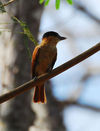Genus Pachyramphus

Xantus' becard - The most distinguishing characteristics of this bird is the rose colored neck bib found in adult males. Males are mostly gray in color, with a contrasting darker upperside and a pale gray underside. Males also show a black crown. Females are mostly brown in color, with a rusty brown upperside, and a pale buffy underside. The crown is a dark gray, not nearly as stunning as the males. Its usual call is a mournful "seeeeuuuwww".
Black-and-white Becard - The Black-and-white Becard is a species of bird in the Tityridae family. It has traditionally been placed in Cotingidae or Tyrannidae, but evidence strongly suggest it is better placed in Tityridae, where now placed by SACC. It is found in Colombia, Costa Rica, Ecuador, Guatemala, Nicaragua, Panama, Peru, and Venezuela. Its natural habitats are subtropical or tropical dry forests and subtropical or tropical moist montane forests.
Chestnut-crowned Becard - It is found in the Amazon Basin of Brazil, Colombia, Peru, Ecuador, and Bolivia and regions of Venezuela; also southeastern regions of South America including Brazil, Paraguay, and very northeastern Argentina. Its natural habitats are subtropical or tropical moist lowland forests, subtropical or tropical moist montane forests, and heavily degraded former forest.
Cinnamon Becard - The adult Cinnamon Becard is 5.5 in long and weighs 0.6-0.8 oz . It is rufous above and paler cinnamon below, with a grey bill and legs. Unlike other becards, the sexes are similar, but the young are brighter above and paler overall. Northern birds have a pale supercilium and dusky line from the bill to the eye, but the subspecies Pachyramphus cinnamomeus magdalenae west of the Andes shows more contrast, with a stronger supercilium and blackish loral line.
One-coloured Becard - The One-colored Becard is a species of bird in the Tityridae family. It has traditionally been placed in Cotingidae or Tyrannidae, but evidence strongly suggest it is better placed in Tityridae, where now placed by SACC. It is found in Colombia, Ecuador, Panama, Peru, and Venezuela. Its natural habitats are subtropical or tropical dry forests, subtropical or tropical moist lowland forests, and heavily degraded former forest.
Gray-collared Becard - It is found in Belize, El Salvador, Guatemala, Honduras, Mexico, and Nicaragua. Its natural habitats are subtropical or tropical dry forests, subtropical or tropical moist lowland forests, and subtropical or tropical moist montane forests.
Black-capped Becard - The Black-capped Becard is a species of bird in the Tityridae family. It has traditionally been placed in Cotingidae or Tyrannidae, but evidence strongly suggest it is better placed in Tityridae, where now placed by SACC. It is found in Bolivia, Brazil, Colombia, Ecuador, French Guiana, Guyana, Peru, Suriname, and Venezuela. Its natural habitat is subtropical or tropical moist lowland forests.
Pink-throated Becard - The Pink-throated Becard is a species of bird in the Tityridae family. It has traditionally been placed in Cotingidae or Tyrannidae, but evidence strongly suggest it is better placed in Tityridae, where now placed by SACC. It is found in Bolivia, Brazil, Colombia, Ecuador, French Guiana, Guyana, Peru, Suriname, and Venezuela. Its natural habitat is subtropical or tropical moist lowland forests.
Jamaican Becard - The Jamaican Becard is a species of bird in the Tityridae family. Its genus, Pachyramphus, has traditionally been placed in Cotingidae or Tyrannidae, but evidence strongly suggest it is better placed in Tityridae. It is endemic to Jamaica. Its natural habitats are subtropical or tropical moist lowland forests and subtropical or tropical moist montane forests.
White-winged Becard - It is found in Argentina, Belize, Bolivia, Brazil, Colombia, Costa Rica, Ecuador, French Guiana, Guatemala, Guyana, Honduras, Mexico, Nicaragua, Panama, Paraguay, Peru, Suriname, Trinidad and Tobago, Uruguay, and Venezuela. Chile is the only country of South America where the White-winged Becard occurs. The White-winged Becard ranges east of the Andes cordillera, except in Colombia and Ecuador.
Cinereous Becard - It is found in Brazil, Colombia, Ecuador, French Guiana, Guyana, Panama, Peru, Suriname, and Venezuela. Its natural habitats are subtropical or tropical moist lowland forests, subtropical or tropical dry shrubland, and heavily degraded former forest.
Slaty Becard - The Slaty Becard is a species of bird in the Tityridae family. It has traditionally been placed in Cotingidae or Tyrannidae, but evidence strongly suggest it is better placed in Tityridae, where now placed by SACC. It is found in Ecuador and Peru. Its natural habitat is subtropical or tropical dry forests. It is threatened by habitat loss.
Glossy-backed Becard - The Glossy-backed Becard is a species of bird in the Tityridae family. It has traditionally been placed in Cotingidae or Tyrannidae, but evidence strongly suggest it is better placed in Tityridae, where now placed by SACC. It is found in Brazil, French Guiana, and Suriname. Its natural habitat is subtropical or tropical moist lowland forests.
Crested Becard - It is found in Argentina, Bolivia, Brazil, Ecuador, Paraguay, and Peru. Its natural habitats are subtropical or tropical moist lowland forests, subtropical or tropical moist montane forests, and heavily degraded former forest.
Barred Becard - The adult Barred Becard is 12 cm long and weighs 14 g; it has a conspicuous eye ring. The adult male has black upperparts with much white in the wings. The sides of the head and throat are yellowish-green shading to white on the rest of the underparts. The underparts are finely barred with black. The adult female has a grey crown and nape, olive-green upperparts and largely rufous wings. The greenish-yellow underparts are finely barred with dusky. Young males are much duller and greener than the adults, with weaker barring. The calls include a soft but persistent weet weet weet weet or a teseep tesep tseep tseep.
Green-backed Becard - It is found in Argentina, Bolivia, Brazil, Guyana, Paraguay, Uruguay, and Venezuela. Its natural habitats are subtropical or tropical moist lowland forests and subtropical or tropical moist montane forests.


